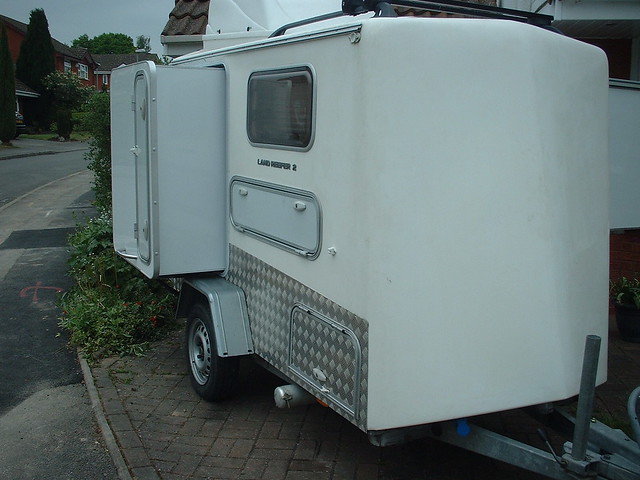ultra lightweight floating popup camper
Thank you for getting the discussion back on track!!
You mentioned that you'd cut with a circular saw because reciprocating saw delaminated the skin, I've used that trick before but not because of the delamination, throw-away skillsaw blades are inexpensive compared to router bits.
Speaking of delamination, I'm wondering if you perforated the insulation skin to allow some epoxy to get underneath the skin a bit and create a better bond. Corecell and divinicell have a rough surface that is porous which makes a lot more surface area for bonding. I took a ride to Lowes last night and they had some blue insulation which seemed to have a smooth surface, I haven't looked at what you were using but I'm guessing that it has a smooth surface as well.
As for the top maybe spending the extra cash on corcell or divinicell would be waranted there as it can be bent with a heat gun.
I have extra glass and epoxy left over from my boat projects so I'm going visit home despot to try and find the foam you used and get a piece of 1/4"birch ply. I am going to build some samples and do some destructive testing on them.
I'm problably going to end up with a heavier trailer as I plan on using 1708 biax cloth, it is a structural cloth that has 1.5oz mat stitched to it and is alot heavier than the stuff you are using. It would still be light but would probably be twice as heavy. In the grand scheme of things, what is 100#?
You mentioned that you'd cut with a circular saw because reciprocating saw delaminated the skin, I've used that trick before but not because of the delamination, throw-away skillsaw blades are inexpensive compared to router bits.
Speaking of delamination, I'm wondering if you perforated the insulation skin to allow some epoxy to get underneath the skin a bit and create a better bond. Corecell and divinicell have a rough surface that is porous which makes a lot more surface area for bonding. I took a ride to Lowes last night and they had some blue insulation which seemed to have a smooth surface, I haven't looked at what you were using but I'm guessing that it has a smooth surface as well.
As for the top maybe spending the extra cash on corcell or divinicell would be waranted there as it can be bent with a heat gun.
I have extra glass and epoxy left over from my boat projects so I'm going visit home despot to try and find the foam you used and get a piece of 1/4"birch ply. I am going to build some samples and do some destructive testing on them.
I'm problably going to end up with a heavier trailer as I plan on using 1708 biax cloth, it is a structural cloth that has 1.5oz mat stitched to it and is alot heavier than the stuff you are using. It would still be light but would probably be twice as heavy. In the grand scheme of things, what is 100#?
- ktm_2000
- Teardrop Master
- Posts: 101
- Joined: Tue Nov 18, 2008 8:08 pm
- Location: Central, MA
coal_burner wrote:i noticed that EVERY one of them failed when the compression side delaminated from the foam and buckled.
It sounds to me like the failure might have been in the foam - did you get some bits of foam still stuck to the 'delaminated' skin? This is exactly what you would expect using a non-structural foam and is really a failure of the foam right next to the skin, not the foam/skin bond.
Paying all that money for Divinycell or CoreCell is what gets you a structural foam, which really is at least as big a difference from insulation foam as hardwoods are from softwoods - just a different animal altogether.
But we're not really comparing similar structures - if you got a boatbuilder to build a teardrop body that was just strong enough, it would be using foam either 3/16" or 1/4" thick foam with very thin skins and the body would weigh tens, not hundreds, of pounds - but it would cost one or two thousand dollars!
Building an insulation-cored body seems perfectly practical to me - but I would be tempted to use either plywood for the skins (since that is made flat and smooth to start with), or to laminate my own fiberglass sheet on a flat mould (a sheet of gloss worktop laminate) and then bond a foam core to that.
Andrew
-

angib - 5000 Club

- Posts: 5783
- Images: 231
- Joined: Fri Apr 30, 2004 2:04 pm
- Location: (Olde) England




